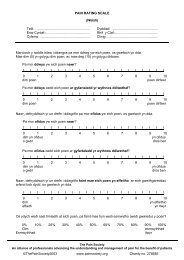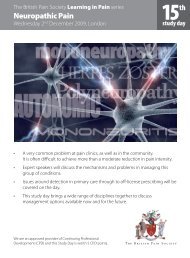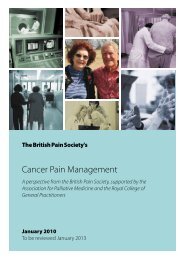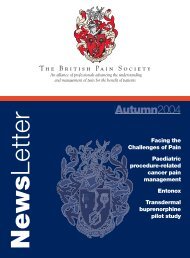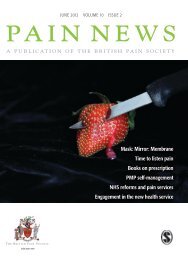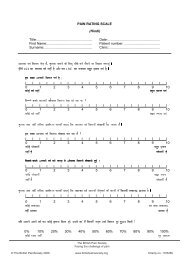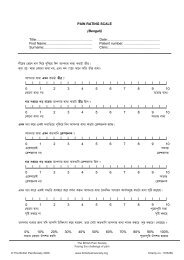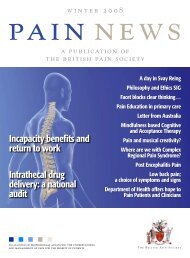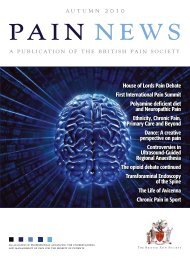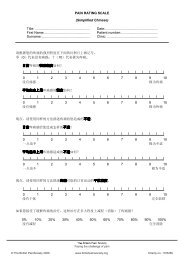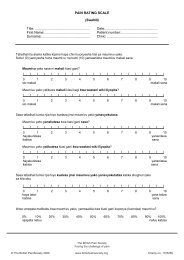Summer 2010 - The British Pain Society
Summer 2010 - The British Pain Society
Summer 2010 - The British Pain Society
You also want an ePaper? Increase the reach of your titles
YUMPU automatically turns print PDFs into web optimized ePapers that Google loves.
PROFESSIONAL PERSPECTIVES<br />
Teaching your<br />
grandmother to suck eggs:<br />
the pain history (101)<br />
Professor Henry McQuay<br />
Oxford<br />
Teaching your grandmother to<br />
suck eggs means that a person<br />
is giving advice to someone else<br />
about a subject that they already<br />
know about (and probably more<br />
than the first person). Wikipedia<br />
suggests the origin was a Punch<br />
cartoon in the 1890s; "You see,<br />
Grandmama, before you extract<br />
the contents of this bird's egg<br />
by suction, you must make an<br />
incision at one extremity, and a<br />
corresponding orifice at the other."<br />
Grandmama's response is to the<br />
effect, "Dearie me! And we used<br />
to just make a hole at each end."<br />
Which sums up my trepidation<br />
at writing about the pain history.<br />
<strong>The</strong>re seems to me no harm and<br />
a lot of potential good in revisiting<br />
the basics. If any of these are<br />
useful to you that’s terrific - if<br />
there are better questions then<br />
that would be a bonus.<br />
How much of the useful<br />
information in a new patient<br />
pain consultation comes from<br />
the history? Most of the time we<br />
work from the patient’s story and<br />
the referral letter, with no other<br />
records available. This may be an<br />
advantage, because you have to<br />
listen. If you can’t get an accurate<br />
story, because of language,<br />
special needs, deafness or speech<br />
difficulties, then you will really<br />
struggle, which just goes to show<br />
how important is the history.<br />
<strong>The</strong> questions you ask and the<br />
way you ask them change over<br />
time. You accrue questions you’ve<br />
heard your colleagues use. You<br />
drop things which don’t help,<br />
and grow those which help you<br />
distinguish. So why focus precious<br />
ink and paper on this topic, taking<br />
a pain history? Because of the<br />
way in which we are increasingly<br />
required to work, paid bum-onseat<br />
with minimal overlap with<br />
colleagues’ sessions and hence<br />
less interaction and conversation.<br />
This means that we have less of a<br />
professional memory on which to<br />
draw, with the threat that you ask<br />
the same questions thirty years on<br />
as you did at the beginning. My<br />
questions draw heavily on those<br />
instilled by our mentor John Lloyd,<br />
on my colleagues Chris Glynn and<br />
Tim Jack, and on the consultants<br />
from different specialties with<br />
whom we did joint clinics. Debt<br />
duly acknowledged.<br />
No matter how long you’ve been<br />
doing this job you can still have<br />
the consultation which runs away<br />
from you. Some of my worst<br />
have been with doctors and their<br />
families, where the plunge into<br />
the details of the most recent<br />
intervention for their problem, or<br />
the quest for the next, derails the<br />
consultation, and gives you the<br />
salutary warning that the structure<br />
of the history is really important.<br />
A blob of drug history, adverse<br />
effects and previous surgeries<br />
can otherwise leave you fifteen<br />
minutes in and none the wiser.<br />
<strong>The</strong> structure of the history is so<br />
crucial, and often the examination<br />
so peripheral, that we gently have<br />
to steer it back.<br />
Some logistic stuff first<br />
How should one arrange the<br />
room?<br />
This always going to be tricky with<br />
the need for wheelchair access,<br />
but should we be learning from<br />
others about desk and chair<br />
positions? Certainly at appraiser<br />
training it was apparent that<br />
there is a wealth of sociological<br />
information on this which I'd<br />
never heard before.<br />
Who else is present makes a<br />
difference<br />
<strong>The</strong> necessity for translation and<br />
the presence of translators which<br />
I alluded to above can create<br />
difficulties. With sons or daughters<br />
translating I'm sometimes unsure<br />
of whose agenda I'm dealing<br />
with. With outsiders translating<br />
a different set of queries arise.<br />
One Chinese patient crept back in<br />
when the translator left and said<br />
“I no come with her anymore.<br />
She no tell the truth.” With patient<br />
advocates the troubles may be<br />
different - hostile anti-doctor<br />
feelings can produce a runaway<br />
consultation. A third party in the<br />
room, a student or a trainee, can<br />
alter the conversation, with the<br />
patient directing remarks to the<br />
third party; for me this has been<br />
more of an issue with followups<br />
than with new consultations,<br />
perhaps because the dynamics<br />
change from the original<br />
one-on-one to a more diffuse<br />
arrangement.<br />
Going out to collect the<br />
patient<br />
John Lloyd used to watch the<br />
patients leaving the clinic from the<br />
window in his office. By walking<br />
with them from the waiting room<br />
to the office you can garner the<br />
same feel for disabilities. Always<br />
invite the accompanying person<br />
(but beware if it is simply the<br />
chauffeur), and beware too asking<br />
the older male (or female) patient<br />
if they’d like their daughter (son)<br />
to come too (yes I've done it).<br />
Where is the pain?<br />
Asking the patient to colour in<br />
which bit(s) hurt on a body<br />
sketch provides a baseline. <strong>The</strong><br />
affected area can shrink over<br />
time (c.f. postherpetic neuralgia),<br />
so the serial chart can provide<br />
some reassurance that things are<br />
improving. In our old notes it’s<br />
common to see Chris Glynn’s<br />
turquoise ink just circling the entire<br />
body - the original ‘widespread’<br />
pain graphic. Important too is to<br />
remember the corollary “Where<br />
doesn’t hurt?”<br />
If I've not asked it anywhere else<br />
then “Is it numb in the affected<br />
area?” should be included,<br />
and the necessary “Does it go<br />
anywhere else?” If the pain does<br />
go somewhere else then what<br />
provokes it to move?<br />
Another way of tracking change<br />
over time is to photograph the<br />
affected parts. Data protection<br />
gets in the way, but getting the<br />
patient to photograph the area on<br />
their mobile phone is an informal<br />
work-around.<br />
What sort of pain is it?<br />
Everybody struggles to describe<br />
their pain. Classically we are taught<br />
to ascribe burning and shooting<br />
descriptors to neuropathic rather<br />
than nociceptive pain, and that’s<br />
probably fair, but neither 100%<br />
specific nor 100% sensitive.<br />
It‘s common for there to be<br />
background pain (which may be<br />
dull) and flare (which may be<br />
sharp) [see below on background<br />
and flare], so one adjective is<br />
unlikely to suffice. Some feel for<br />
intensity is helpful too - “on a<br />
scale of 0 to 10 it’s a 12”. Again<br />
these numbers can be used in<br />
subsequent appointments to<br />
monitor progress.<br />
If it’s not already clear by this<br />
stage in the history then once<br />
again a primary focus of these<br />
questions is to help you decide<br />
if the pain is nociceptive or<br />
neuropathic, because this is such a<br />
huge distinction when it comes to<br />
treatment, one pharmacopeia for<br />
one and one for the other (well<br />
nearly).<br />
PAI N N E W S S U M M E R <strong>2010</strong> 45




